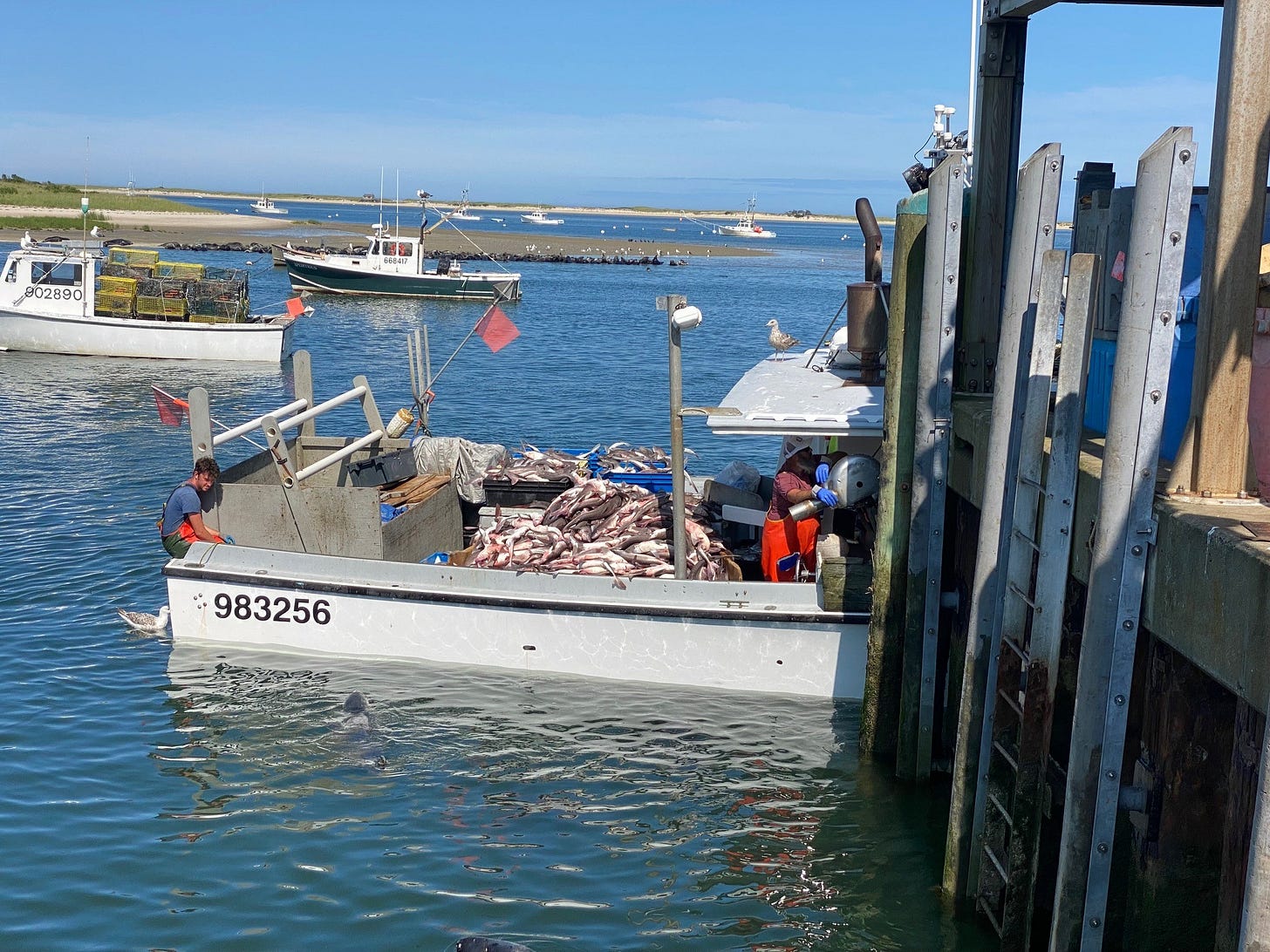
People say half-facetiously that we should accept reality and change the name of this sandspit to Cape Dog.
Dogfish abound in local waters — not as much as cod back when exaggerating explorers said you could walk on codfish backs, the first of many marketing ploys to entice people to this so-called “New World.” But dogs have replaced the famous namesake as the go-to fish for a lot of local captains.
Dogs, small sharks, roam a chunk of the year so predictably that fishermen might think of catching them as boring, repetitive. People don’t get into fishing for boredom, or repetition. They prefer hunt and chase. But dogging is on the water, and a living.
Given low prices fetched for landing dogs, it takes weight to make trips worthwhile. The daily limit in state waters, within three miles of shore, changes over time but can be 4000, 5000, even 7500 pounds. That is done so efficiently that fishermen leaving early in the morning often can be home for a late lunch, also landing other catch like skates.
The math adds up provided you work hard, keep a crew, maintain the boat, and can handle repetition.
Most of us have heard that dogfish are or were the fish of fish and chips in England, but don’t know why. Here it is:
During World War Two, German U-boats (submarines) terrorized the British coast. Fishermen had to stay close to shore to catch what they could. That was dogfish, which made its way to pubs as the only option, and people developed a taste for it.
Brits fished dogs so hard they became scarce. The last time I was in Northwest Ireland, I sat with a handful of fishermen in a pub (where else?) and told them that where I come from, their counterparts land thousands of pounds of dogfish day after day, boat after boat.
Several burly guys stumbled off their stools (some Guinness was involved) to proclaim that if they could do that, they’d own the town.
Too bad that’s not true — there or here.
On our side of the Atlantic, lower value has to do with marketing and appetites.
The name isn’t the greatest far as consumer attraction goes; no one likes thinking about eating dogs, though hot dogs surely are popular, and catfish has its place.
Attempts to change the name go back to 1916, with an official push to rename dogs “grayfish.”
Didn’t work then, wouldn’t now.
The impetus is not foolish; changing a name can change consumer attitudes. A species in southern waters was known as “toothfish,” and guess what? No one wanted to eat teeth.
Then people convinced the Food and Drug Administration it wouldn’t be false advertising to call them “Chilean sea bass.”
Sales rocketed.
There’s also taste. Many prefer dogfish disguised in tomato stews or blanketed by spices and veggies, wrapped in tacos. But if cod and haddock were piled on a hot deck, not bled and iced right away, their taste might well suffer.
Tuna come to mind:
Within this lifetime giant tuna sold for pennies a pound as catfood. Then the Japanese showed up, insisted on great care for each animal, and built a Tokyo market fetching many yen a gram, many dollars here.
Dogfish ain’t sushi-grade tuna, but are victims of a Catch 22:
There is no financial incentive to handle them better, and unless they’re handled better the price won’t climb — which would create financial incentive to handle them better.
You might figure with all the regulations to bring codfish back, this dogfish conversation will become moot.
But don’t hold your breath for inshore codfish returning in abundance; between seals and dogs, there’s too much predator pressure and competition.
Add warming water:
Cod are heading east and north (like a lot of ocean things) to get to temperatures they prefer, around 59 degrees.
So big picture, the presence of dogs expresses two things:
First, the ocean is amazingly fertile. Creation happens.
Second, while Nature abhors a vacuum, it could care less about human taste.
Something was sure to replace codfish; turned out to be dogs. If we enjoyed eating them more we wouldn’t mind nearly as much.
Maybe when dogfish get scarce they’ll become a delicacy like in England — but regardless, this will remain Cape Cod.
Haven’t subscribed yet? With all due respect, why not? Make it possible to see a Voice and support good reporting, strong perspectives, unique Cape Cod takes every week. All that for far less than a cup of coffee. Please subscribe:
https://sethrolbein.substack.com/welcome
And if you are into Instagram, want to see some additional material, maybe share the work, here you go:





i meet dogfish now and than in the fjords i dive. Not every year, but now and than in the autum. They come in the thousands and are all pregnant. They attack the salmon pens to feast on the dead salmons. I go down and repair the nets. I think they taste good. But it is totally forbidden to catch and eat them. They are protected. They are called pigghå ( spiny dogfish) in Norwegian, because of there sting in there upper fins.
Enjoyed the above post as much as the article….